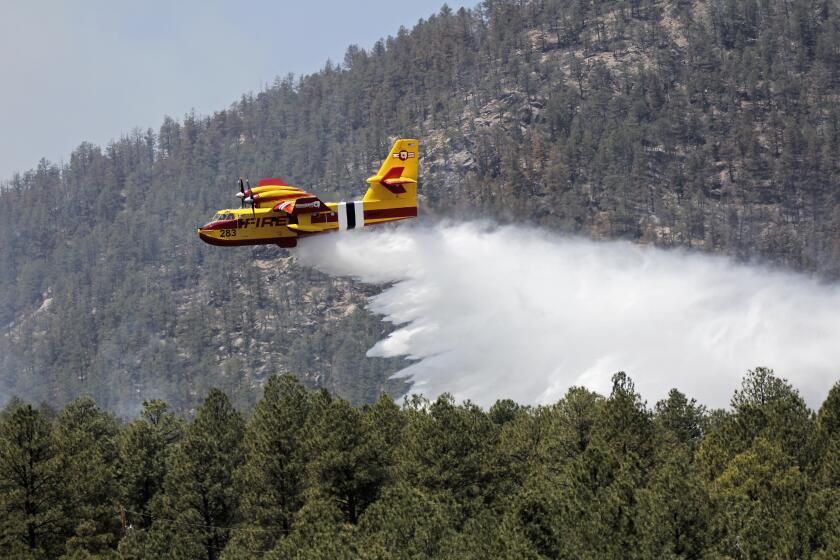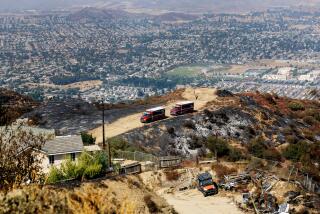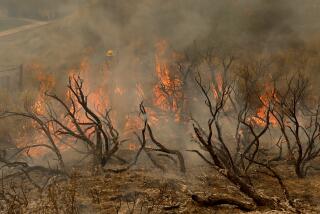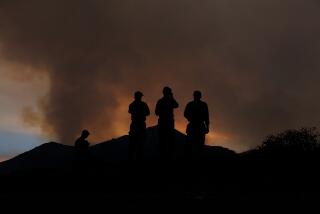As wildfire closes in, New Mexico residents prepare to flee
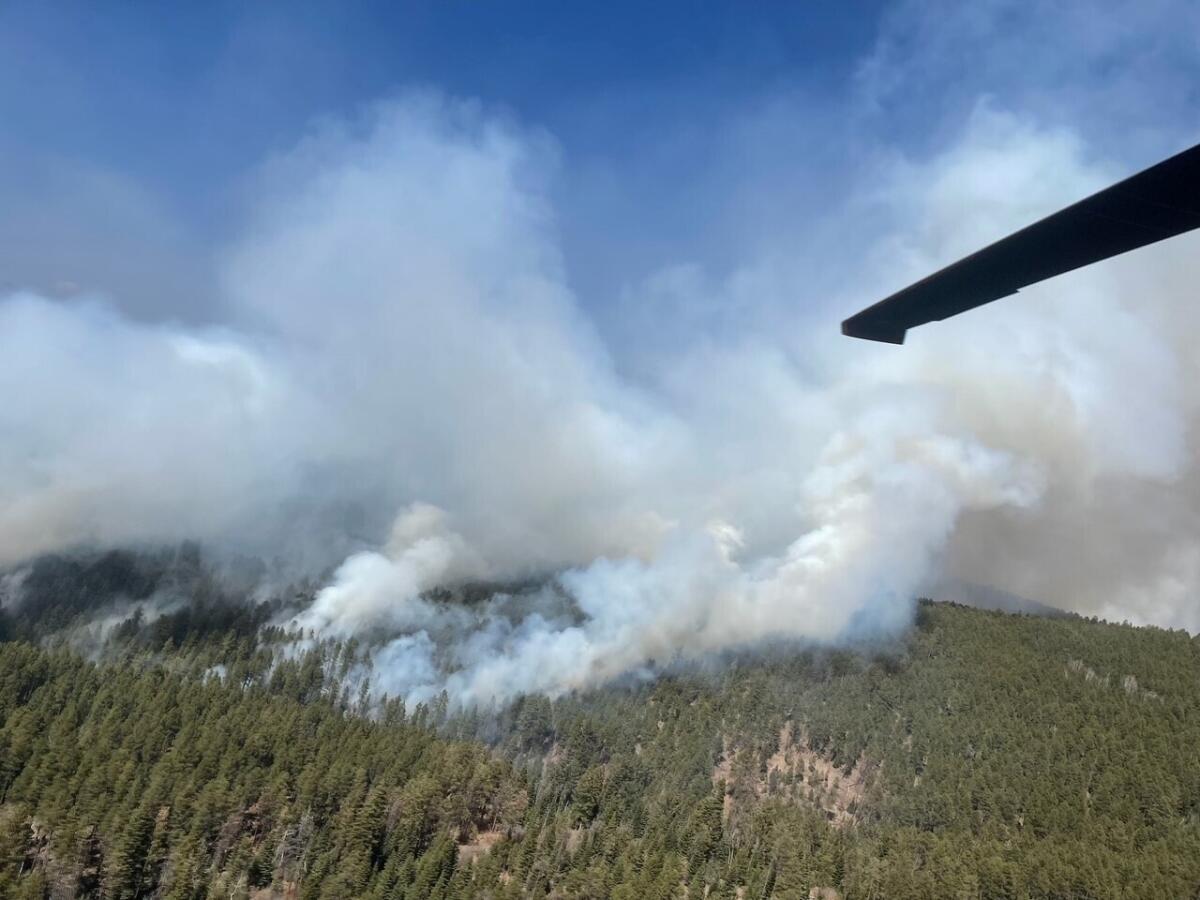
- Share via
ALBUQUERQUE — Wind-whipped flames raced across more of New Mexico’s pine-covered mountainsides Monday, closing in on a town of 13,000 people where some residents hurried to pack their cars with belongings, others hustled to clear brush from around their homes, and police were called in to help evacuate the state’s psychiatric hospital.
Firefighting crews were battling to keep the fire, the largest burning in the U.S., from making another run across the state’s drought-parched landscape. The fire already has charred more than 188 square miles, and flames could be seen from the small northeastern New Mexico city of Las Vegas just a couple of miles away.
Fire officials said they expect the blaze to keep growing, putting it on track to be one of the largest and most destructive in the state’s recorded history.
The sky above the city’s historic plaza, made famous as a backdrop in several movies and television series, was a sickly tinge of yellow and gray as thick smoke blotted out the sun. As ash fell around them, Chris Castillo and his cousins were cutting down trees and moving logs away from a family member’s home.
“We’re all family here. We’re trying to make a fire line,” he said.
Other family members were driving around with cattle trailers, ready to help anyone who calls to move livestock.
Wildfires have become a year-round threat in the drought-stricken West and they are moving faster and burning hotter than ever because of climate change, scientists and fire experts say. In the last five years, California, for example, has experienced the eight largest wildfires in state history, and Colorado saw a destructive blaze tear through suburban neighborhoods last December.
Fire officials warned Monday that the fire in northern New Mexico would keep spreading at dangerous speeds and in different directions because of shifting winds, low humidity and high temperatures. They said the majority of the coming days could see more high winds that would make suppression efforts difficult.
“This is a long-term event, and we don’t anticipate having ‘control’ of this fire any time soon,” fire officials said in an update Monday.
More of the dry, windy weather that helped fan spring wildfires from New Mexico to Nebraska is threatening to test the progress firefighters have made.
The fire — fanned by an extended period of hot, dry and windy conditions — ballooned in size Sunday, prompting authorities to issue new evacuation orders for the small town of Mora and other villages.
Residents in some outlying neighborhoods of Las Vegas were told to be ready to leave their homes as thick smoke choked the economic hub for the farming and ranching families that have lived for generations in the rural region. It’s also home to New Mexico Highlands University and is one of the most populated stops along Interstate 25 before the Colorado state line.
Operations Section Chief Todd Abel said Monday that crews were busy using bulldozers to build fire lines to keep the flames from pushing into neighborhoods.
Fire information officer Mike De Fries said crews got a bit of a break Monday afternoon as the wind diminished and helicopters were able to make water drops in key locations. Still, flames running along the ridges above town could be seen from the discount store, an empty baseball field and other vantage points.
The county jail, the state’s psychiatric hospital and more than 200 students from the United World College have evacuated, and what businesses remained open were having a hard time finding workers as more people were forced from their homes.
“We’re trying to house and feed people with skeleton crews. Hundreds of people have lost their homes. It’s an extraordinary tragedy,” said Allan Affeldt, a hotelier in Las Vegas. He said most of his staff were evacuated from their homes and he canceled guest reservations to accommodate firefighters and emergency crews.
The 197 patients at the Behavioral Health Institute were being sent to other facilities around the state, with some being transported in secured units and others escorted by police.
State environmental authorities and officials in Las Vegas also were asking people to conserve water to ensure fire crews have enough to fight the blaze.
Across New Mexico, officials and groups were collecting food, water and other supplies for the thousands of people displaced by the fires. Offers of prayers and hope flooded social media as residents posted photos of the flames torching the tops of towering ponderosa pines near their homes. Some of those living close to the fires described the week that the fire has raged nearby as gut-wrenching.
On the northern flank of the fire, evacuees streamed uphill Monday out of the Mora River valley over passes of the Sangre de Cristo Mountains. State Rep. Roger Montoya, from the mountain hamlet of Chacon, said neighbors were putting what they couldn’t carry with them into metal containers and leaving them in irrigating fields, hoping the moisture would offer some protection.
Officials have said the northeastern New Mexico fire has damaged or destroyed 172 homes and at least 116 structures.
It merged last week with another blaze that was sparked in early April when a prescribed fire escaped containment after being set by land managers to clear brush and small trees in hopes of reducing the fire danger. The cause of the other fire is still under investigation.
Jesus Romero, the deputy manager of San Miguel County, on Monday was helping family monitor their home amid smoky ash-laden air. He cut down trees around his garage as a fire-prevention measure and talked with other residents who were undecided about whether to leave. He called the situation serious.
Another New Mexico wildfire burning in the mountains near Los Alamos National Laboratory also prompted more evacuations over the weekend and other communities were told to get ready to evacuate if conditions worsen. It has reached the burn scars of wildfires that blackened the region a decade ago when New Mexico had one of its worst and most destructive seasons.
A wildfire in 2000 forced the closure of the laboratory and left about 400 people homeless. The community was threatened again in 2011 when another blaze caused by a downed power line blackened more of the surrounding forest.
In the southern New Mexico community of Ruidoso, two people were killed in a wildfire that destroyed more than 200 homes in April. That mountain community saw similar destruction from a 2012 fire.
And new wildfires were reported over the weekend — three in Texas, two in New Mexico and one each in Oklahoma and Tennessee, according to the National Interagency Fire Center. More than 3,100 wildland firefighters and support personnel are fighting fires across the country, with about one-third of them trying to prevent the big blaze in New Mexico from spreading.
More than 4,400 square miles have burned across the U.S. so far this year.
More to Read
Sign up for Essential California
The most important California stories and recommendations in your inbox every morning.
You may occasionally receive promotional content from the Los Angeles Times.
